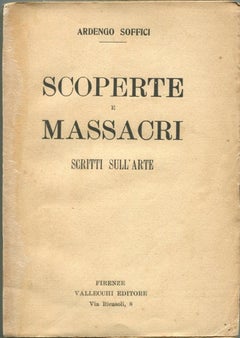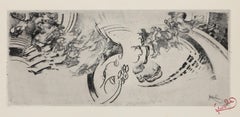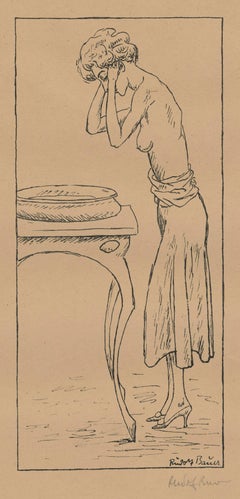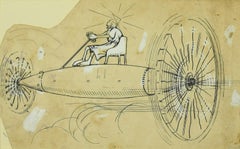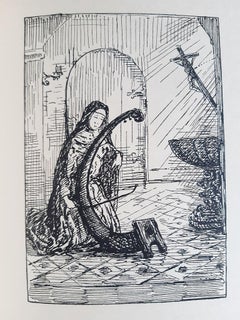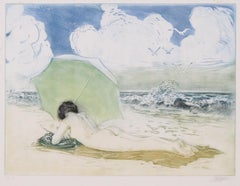1910s Art
to
277
1,102
351
373
172
164
Overall Width
to
Overall Height
to
7,555
20,986
156,704
235,200
1,863
2,214
4,764
6,460
5,820
13,118
19,572
25,079
17,314
13,353
5,325
425
304
136
123
45
18
17
6
5
1
1,208
857
30
1,422
700
586
426
389
355
219
146
136
136
133
121
117
99
87
85
80
74
55
54
808
571
461
389
352
101
47
34
24
22
796
361
1,177
908
Period: 1910s
Scoperte e Massacri, Scritti...- Rare Book Illustrated by Ardengo Soffici - 1919
Located in Roma, IT
Volume on the art by Ardengo Soffici (Rignano sull'Arno,1879 – Vittoria Apuana,1964). The texts are mainly a collection of art critics first published by Soffici on the italian magaz...
Category
Surrealist 1910s Art
Materials
Paper
Abstract Composition, Surrealist Etching by Frantisek Kupka
Located in Long Island City, NY
Frantisek Kupka, Czech (1871 - 1957) - Abstract Composition. Year: 1913, Medium: Etching on Richard de Bas, stamp signed and signed in the plate, Image Size: 6 x 13.5 inches, Size: 1...
Category
Surrealist 1910s Art
Materials
Etching
untitled (Young Woman Washing)
By Rudolf Bauer
Located in Fairlawn, OH
untitled (Young Woman Washing)
Lithograph, c. 1910
Signed in pencil lower right; signed in the plate lower right (see photo)
Image size: 11 x 5-1/8"
Sheet size: 18 7/8 x 12 5/8 inches
Condition: Very good
Aging to the tan paper it is printed on
Provenance: Estate of the Artist
Borghi & Company, NYC
Rudolph Bauer
1889-1953
Rudolf Bauer was born in Lindenwald near Bromberg, Silesia, in 1889 but his family moved only a few years later to Berlin. In 1905 Bauer began his studies at the Berlin Academy of Art but left the Academy only a few months later to educate himself. The upshot was paintings, caricatures and comical drawings which were published in 'Berliner Tageblatt', 'Ulk' and 'Le Figaro'.
From 1912 Bauer contributed to the magazine and Gallery 'Der Sturm' founded by Herwarth Walden and pivotal to German Expressionism and the international avant-garde. In 1915 Rudolf Bauer participated for the first time in a group show at Walden's gallery. There he met Hilla von Rebay, with whom he began a relationship of many years that was crucial to Bauer's later work. By 1922 Bauer had shown work at about eight exhibitions mounted by 'Der Sturm'. From 1918 he also taught at the 'Der Sturm' art school, where Georg Muche was the director. After the war ended, Bauer was a founding member of the 'November Group' although he did not collaborate closely with the group. In 1919 Bauer joined forces with the painter and architect Otto Nebel and with Hilla von Rebay to found the artists' association 'Die Krater'. Impressionist at the outset, Bauer's early work reveals Cubist and Expressionist influences. By 1915/16 Bauer had switched to an abstract pictorial idiom, which is markedly influenced by Kandinsky. In the early 1920s Bauer was also preoccupied with Russian Constructivism as well as the Dutch de Stijl group. Bauer's decided preference for non-representational painting culminated in 1929 with the foundation of a private museum, 'Das Geistreich', which he directed as a salon for abstract art.
Political developments in Germany forced Bauer to sell some of his work in America from 1932. His agent in America was Hilla von Rebay, who was by now director of the Guggenheim Collection. In 1936 she organized a touring exhibition of non-representational European art that included sixty Rudolf Bauer oil...
Category
Jugendstil 1910s Art
Materials
Lithograph
The Flight - Original Pen on Paper by G. Galantara - 1910 ca
Located in Roma, IT
The Flight is an original drawing in pencil and pen on paper by Gabriele Galantara (1865-1937).
In good conditions except for some diffused foxings and some small holes.
Sheet dime...
Category
1910s Art
Materials
Paper, Pen
Der Todseher - Rare Book Illustrated by Alfred Kubin - 1910
Located in Roma, IT
Der Todseher is an original modern rare book written by Ernst Adolf Willkomm (Herwigsdorf, 1810 - Zittau, 1886) and illustrated by Alfred Leopold Isidor Kubin (Leitmeritz, 1877 – Zwickledt, 1959) in 1910.
Original Edition.
Published by Barsdorf, Berlin.
30 numbered copies of deluxe issue.
Format: in 8°.
The book includes 284 pages with six full page drawings.
Mint conditions.
Alfred Leopold Isidor Kubin (Leitmeritz, 1877 – Zwickledt, 1959) in 1910. He was an Austrian printmaker, illustrator, and occasional writer. Kubin is considered an important representative of Symbolism and Expressionism. Kubin is considered an important representative of Symbolism and Expressionism and is noted for dark, spectral, symbolic fantasies, often assembled into thematic series of drawings. Like Oskar Kokoschka and Albert Paris Gütersloh, Kubin had both artistic and literary talent. He illustrated the works of Edgar Allan Poe, E. T. A. Hoffmann, and Fyodor Dostoevsky, among others. Kubin also illustrated the German fantasy magazine Der Orchideengarten.
Ernst Adolf Willkomm (Herwigsdorf, 1810 - Zittau, 1886). Willkomm was a German writer. Willkomm has published time-critical novels, travel sketches and short stories. With the title of his novel Die Europamüden in 1838 he took up a key word that had been coined by Heine in 1828 and with which an important aspect of thinking in the Vormärz was recorded. In the years 1845/46 Willkomm undertook a trip to Italy, whose experiences he processed in 1847 in the travel sketches Italian...
Category
Symbolist 1910s Art
Materials
Paper, Photogravure
Sunbathing
Located in Fairlawn, OH
Sunbathing
Etching and color aquatint on watermarked Umbria Italy paper, c. 1915
Signed by the artist in pencil lower right (see photo)
Annotated: "No. 6" in pencil lower left (see photo)
An early color print by the artist
Condition: Excellent
Plate size: 11-3/4 x 15-7-8" (30 x 40.3 cm.)
Frame size: 21 x 26 1/8 x 1 inches
Provenance: Estate of the artist
By decent
Louis Oscar Griffith
(1875-1956)
Born in Greencastle, Indiana, Griffith grew up in Dallas, Texas where Texas artist and teacher Charles Franklin Reaugh recognized young “Griff’s” artistic talent. At age 18, Griffith moved to St. Louis where he attended the St. Louis School of Fine Arts.
In 1895, he moved to Chicago where he worked making color prints for the firm Barnes and Crosby. He attended the Art Institute of Chicago and during a brief stay in New York, the National Academy of Design. A successful commercial artist with a studio in the Chicago Loop...
Category
American Impressionist 1910s Art
Materials
Etching
Sculptured Drum, British Museum Greek Roman Classical sculpture photogravure
Located in Melbourne, Victoria
'Sculptured Drum, Temple of Artemis, Ephesus'
Photogravure from a collection of photogravures depicting Greek and Roman marbles and bronzes in the British museum. Plate number above...
Category
Other Art Style 1910s Art
Materials
Photogravure
Erotic Scene - Héliogravure by Micheal Von Zichy - 1911
Located in Roma, IT
Erotic scene is an original Héliogravure artwork on ivory-colored paper, realized by Micheal Von Zichy in 1911. Printed in only 300 copies, Leipzig; Privatdruck, from the Catalogue ...
Category
Modern 1910s Art
Materials
Paper, Engraving
Le Veilleur de Nuit - Rare Book by Sacha Guitry - 1910s
Located in Roma, IT
Edition of 15 copies on papier du Japon. Soft editorial cover. Lightly worn on cover and on binding. Very good conditions.
Category
Modern 1910s Art
Materials
Paper
Fragment en Prose - Rare Book - 1920s
Located in Roma, IT
Translated in french by Maurice Betz, from the original "Prosafragmente" by Rainer Maria Rilke. Edition of 675 copies. Copy on Outhenin-Chalandre paper. Spine lightly worn, perfect c...
Category
Surrealist 1910s Art
Materials
Paper
St Etheldreda's Fulham WW1 commemorative window design by Reginald Hallward
Located in London, GB
To see more, scroll down to "More from this Seller" and below it click on "See all from this Seller."
Reginald Hallward (1858 - 1948)
Stained glass window design for St Etheldreda'...
Category
1910s Art
Materials
Pencil, Gouache
Apollo from Cyrene, British Museum Roman Classical sculpture photogravure
Located in Melbourne, Victoria
'Apollo from Cyrene'
Photogravure from a collection of photogravures depicting Greek and Roman marbles and bronzes in the British museum. Plate number above top right corner of the ...
Category
Other Art Style 1910s Art
Materials
Photogravure
The Portland Vase, British Museum Roman antiquity photogravure
Located in Melbourne, Victoria
'The Portland Vase'
Photogravure after Donald Macbeth (1865-1943).
Donald Macbeth was a commercial photographer who seems to have held a quasi-official position at the British Muse...
Category
Other Art Style 1910s Art
Materials
Photogravure
Ex-Libris - Woodcut - 1911
Located in Roma, IT
Ex-Libris -B. Sigales is an Artwork realized in 1911.
Woodcut print on paper. The work is glued on ivory cardboard.
Total dimensions: 21 x 15 cm.
Excellent conditions.
The arti...
Category
Modern 1910s Art
Materials
Woodcut
Ikarus und Daedalus - Etching by Fritz Zalisz - 1914
By Fritz Zalisz
Located in Roma, IT
Ikarus und Daedalus is a beautiful etching and aquatint on ivory-colored paper realized in 1914 by the German expressionist artist, Fritz Zalisz (Gera 1893 - Holzhausen 1971).
Signature and date in pencil on the lower right margin.
In the etching on the lower margin, a long print inscription: "Betet nicht mehr! -Das sollt ihr mir schworen, brigt keine Opfer mehr, das sollt ihr geloben! - Herbert Eulenberg dem Dichter von Ikarus und Daedalus gewidmet. FZ".
This dedicatory inscription refers to the well-known German poet and writer Herbert Eulenberg (1876-1949) who wrote the book "Ikarus und Daedalus. Ein Oratorium", Leipzig 1912.
This original print represents the myth of Icarus and Dedalus with a suggestive symbolist composition, preserved nice impression and is in excellent condition.
Fritz Zalisz (Gera 1893 - Holzhausen 1971).
The German painter, graphic designer and sculptor Fritz Zalisz, considered one of the most important representatives of German expressionism, studied at the Leipzig Academy with Otto Richard Bossert and Alois Kolb...
Category
Symbolist 1910s Art
Materials
Etching
Original watercolour Nude by Antoine Calbet
Located in Pasadena, CA
Antoine Calbet presents his works, mainly portraits and genre scenes, at the Salons of the Société des artistes français from 1881 until 1940, as well as at the international exhibit...
Category
Art Nouveau 1910s Art
Materials
Pastel, Watercolor
Inlet and Windmill Landscape
By William Walker Alexander
Located in Soquel, CA
Inlet and windmill, a watercolor painting by William Walker Alexander (Canadian, 1870-1948). Presented a giltwood frame. Signed "W.W Alexander" lower right. Inner mat has minor wear ...
Category
Impressionist 1910s Art
Materials
Paper, Watercolor
$680 Sale Price
20% Off
Les Otages Civils
Located in San Francisco, CA
This artwork titled, Les Otages Civils, 1916 is an original lithograph on Japan paper by Swiss/French artist Theophile Alexandre Steinlen, 1859-1923. It is signed and numbered out of...
Category
Impressionist 1910s Art
Materials
Lithograph
Original circa 1915 lithographic poster - Panorama de la Bataille de la Marne
Located in PARIS, FR
This original circa 1915 lithographic poster by artist T. Sala, titled Panorama de la Bataille de la Marne, stands as a compelling and highly rare visual testament to one of the defi...
Category
1910s Art
Materials
Paper, Lithograph
Original Watercolour by Delovincourt Fashion Signed
Located in Pasadena, CA
Delovincourt: biography
Delovincourt, is a poster artist. Delovincourt was an art nouveau artist. He was mainly active during the modern period.
Delovincourt: his main works
Delovinc...
Category
Art Nouveau 1910s Art
Materials
Archival Paper
Military - Original Etching by Anselmo Bucci - 1917
Located in Roma, IT
"Military" is a beautiful print in the etching technique, realized by Anselmo Bucci (1887-1955).
Anselmo Bucci (1887-1955): Italian painter, engraver, and writer, one of the initiat...
Category
Modern 1910s Art
Materials
Etching
The Bottle - Drawing by Giuseppe Scalarini - 1918
Located in Roma, IT
The Bottle is a drawing artwork in Black Marker on paper realized by Italian Artist Giuseppe Scalarini (Mantova, 29 Gennaio 1873 – Milano, 30 December 1948).
The state of preservati...
Category
Modern 1910s Art
Materials
Paper, Permanent Marker
The Wake up - Original Drawing by Gabriele Galantara - 1910
Located in Roma, IT
The wake up is an original drawing in pencil and china ink realized by Gabriele Galantara in 1910 for the front of a new newspaper.
Titled in Italian "La Sveglia".
The state of pre...
Category
Modern 1910s Art
Materials
Pencil, Ink
Ex Libris - Woodcut by M. Pot Van Regteren Altena - 1914
Located in Roma, IT
Ex Libris - Pie Perite Patienter Collectis J. Souverein is a Modern Artwork realized in 1914, by M. Pot Van Regteren Altena, from Nederland.
B/W Woodcut on ivory paper. Signed on p...
Category
Modern 1910s Art
Materials
Paper, Woodcut
1916 poster for the Grande Matinée Artistique en l'Honneur de Raemaekers
Located in PARIS, FR
During World War I, artistic and cultural events played a crucial role in supporting humanitarian efforts and boosting morale. Among the notable artifacts from this period is the 191...
Category
1910s Art
Materials
Lithograph, Paper
Beauregard House, New Orleans
Located in New Orleans, LA
Louis Oscar Griffith (1875-1956) was an American painter known for his etchings, paintings, and aquatints of landscapes, especially scenes of Brown County, Indiana, New Orleans, LA and Texas. Griffith was born in Indiana in 1875 but later moved to Dallas, TX with his family. As a teen, he took art lessons with acclaimed landscape artist, Frank Reaugh...
Category
Impressionist 1910s Art
Materials
Paper, Graphite
The Apparition - Original Ink - 1918
Located in Roma, IT
The apparition is an original artwork realized in 1918 and signed and dated "Hinault 1918"
Black and white china ink, watercolor and biacca drawing .Hand signed Hinault and dated on...
Category
Modern 1910s Art
Materials
Ink
The European Macabre Dance N.4 - Lithograph by A. Martini - 1915
Located in Roma, IT
The European Macabre Dance N.4 is a hand-colored lithograph, from the Series "La Danza Macabra Europea" illustrated by Alberto Martini (Oderzo, 1876 – Milan, 1954) in 1915.
Signed ...
Category
Symbolist 1910s Art
Materials
Lithograph
The Joys of the Hairy - Woodcut Print by Pierre Abadie-Landel - 1917
Located in Roma, IT
The Joys of the Hairy is a woodcut print realized by Pierre Abadie-Landel (1896-1972) in 1917.
This woodcut print is contained in a white passepartout (40x32.5 cm).
Good condition....
Category
Modern 1910s Art
Materials
Woodcut
Ex Libris - N. Sigale's - Woodcut by José (Josepe) Viola - 1911
Located in Roma, IT
Ex Libris - N. Sigale's is a Modern Artwork realized in 1911 s. by José (Josepe) Viola.
Ex Libris. B/W woodcut on paper.
The work is glued on ivory cardboard. Signed on plate an...
Category
Modern 1910s Art
Materials
Woodcut
"Ekamka Fetish - Nigeria, " Carved Wood Figure created circa 1910
Located in Milwaukee, WI
This Ekamka Fetish sculpture was carved from wood by an unknown Nigerian artist. It depicts a figure holding a mask. The figure has two symbolic horns protruding from his head and he sits on a thin...
Category
Folk Art 1910s Art
Materials
Wood
George Washington Hand Studies, Mount Vernon
Located in Greenwich, CT
This stunning study of George Washington's hands is a unique and remarkable drawing pair. Mora was noted as an exceptional draftsman and actually traveled america giving lectures ab...
Category
American Realist 1910s Art
Materials
Paper, Charcoal
Der Zauberer - Engrave by Karl Thylmann -1919s
Located in Roma, IT
Der Zauberer is an original modern rare Book engraved by Karl Thylmann (Darmstadt, 1888 - Groß-Auheim, 1916) and written by Nikolaj Gogol in 1919.
Original First Edition.
1000 unnumbered copies.
Published by Kurt Wolf Verlag, Leipzig.
Format: in 8°. The dimensions and the weight of the book are indicative.
The artwork includes 101 pages with 12 full page woodcuts.
Mint conditions.
Karl Thylmann (Darmstadt, 1888 - Groß-Auheim, 1916). He was a German book artist , graphic artist and poet. n Darmstadt, the son of a senior teacher attended the Ludwig-Georgs-Gymnasium , where he made the acquaintance of the later composer Wilhelm Petersen . During his architecture studies at the Technical University of Munich , he also got to know Stefan George...
Category
Modern 1910s Art
Materials
Paper
Reims The Cathedral in Flames - Original Lithographby Charles Jouas - 1914
Located in Roma, IT
Reims The Cathedral in Flames is a Lithograph realized by Charles jouas in 1914.
Good condition on a yellowed paper.
Titled and dated on the upper margin, Editor and gallery on the...
Category
Modern 1910s Art
Materials
Paper, Lithograph
Oil Painting by Charles Henry Burleigh "The Farm"
Located in Mere, GB
Oil Painting by Charles Henry Burleigh "The Farmstead" R.B.A 1875- 1956 Brighton painter member of the Royal of Institute of painters. Also ex...
Category
1910s Art
Materials
Oil
Joseph Pennell
Located in Fairlawn, OH
Signed and dated in pencil verso
Titled "Joseph Pennell" recto
Annotated verso:
Adolph a Dehn
Oct. 5 1915
Tonight I saw a duplicate of Whistler -- "Joseph Pennell." Bu...
Category
1910s Art
Materials
Graphite
Original 1914 Ski Poster Zug Berg-u-Strassenbahn, Austria: Walther Koch - Skiing
By Walter Koch
Located in London, GB
Walther Koch (1875-1915)
Zug Berg und Strassenbahn
Original lithographic poster (1914)
40x30"
Printed in Zurich by Anstalt Gebr Fretz
Category
Modern 1910s Art
Materials
Lithograph
Le Livre De Ceux Qui Sont Restés - Woodcut by Louis Bouquet - 1916
Located in Roma, IT
Le Livre De Ceux Qui Sont Restés is a booklet of woodcut prints realized by Louis Bouquet in 1916.
Edition" Nouvel Essor" Paris.
Included 9 prints.
Go...
Category
Modern 1910s Art
Materials
Woodcut
Figure with Guitar II
By Henry Fitch Taylor
Located in Bryn Mawr, PA
Provenance
Noah Goldowsky Gallery, New York;
Collection of Jeptha H. Wade and Emily Vanderbilt Wade, Boston, until 2025
Exhibitions
Cleveland Museum of Art, Art for Collectors, 1971...
Category
American Modern 1910s Art
Materials
Canvas, Oil
Woodlands (Double-sided), Impressionist Watercolor on Paper by William Zorach
Located in Long Island City, NY
William Zorach, Lithuanian (1887 - 1966) - Woodlands (Double-sided), Year: 1913, Medium: Watercolor on Paper, signed and dated in pencil, with Graphite Drawing on verso, Size: 8.5 ...
Category
Impressionist 1910s Art
Materials
Watercolor
Fruit Sellers - Lithograph by Georges Gobo - 1910s
By Georges Gobo
Located in Roma, IT
Fruit Sellers is a lithograph on ivory-colored paper realized by Georges Gobo.
Signed on the plate.
Good Conditions with slight foxing.
The artwork is created through deft rapid str...
Category
Modern 1910s Art
Materials
Lithograph
Henry Ottmann (1877-1927) A forest in the mist, pastel signed
Located in Paris, FR
Henry Ottmann (1877-1927)
"Orée du bois par brume", A forest in the mist
signed lower right
pastel on paper
24 x 32 cm
In good condition
In a vintage frame : 43.5 x 53 cm The gilding on the frame is missing in many places
Henry Ottmann particularly excelled in the pastel technique, as can be seen here.
This is due to the fact that this delicate material obviously lends itself very well to the artist's characteristic vaporous style and manner.
We should also note the great modernity of this landscape and its fades, which go almost as far as abstraction.
Henry Ottmann was born on 10 April 1877 in Ancenis.
He made his debut at the Salon La Libre Esthétique in Brussels in 1904 and took part in the Salon des Indépendants in Paris from 1905, the Salon d'Automne, the Salon de la Société Nationale des Beaux-Arts and the Salon des Tuileries.
In 1911 and 1912, Ottmann exhibited at the Artistes de la Société Moderne at the Gallery Paul Durand-Ruel together with Armand Guillaumin, Henri Lebasque and others. In 1912, he exhibited at the gallery Eugène Druet.
In 1920, Ottmann exhibited at the gallery Marcel...
Category
Post-Impressionist 1910s Art
Materials
Pastel
Landscape in Lagny - Original Drawing by Paul Alouard-Carny - 1936
Located in Roma, IT
Landscape in Lagny is an Original Pastel and Watercolour realized by Paul Alouard-Carny (1884-1961) in 1936.
Good condition on a yellowed paper.
Hand-signed by the artist on the lo...
Category
Modern 1910s Art
Materials
Pastel
Alea Iacta Est - Etching by Benito (Edmond Garcia) - 1914
Located in Roma, IT
Alea Iacta Est is an original etching realized in1914 by Benito (Edmond Garcia, 1891-1961).
Good condition. Edition 29/50
The artwork is depicted through strong strokes in a well-b...
Category
Modern 1910s Art
Materials
Etching
1910 original poster by Geo Bric "Le Zodiac III" dirigible balloon
Located in PARIS, FR
In 1910, Geo Bric unveiled his original poster "Le Zodiac III", featuring an airship or dirigible balloon. This remarkable artwork depicted the sleek and majestic form of the airship...
Category
1910s Art
Materials
Lithograph, Paper
Magazine "Numero" number 76 - Original Lithograph - 1910s
Located in Roma, IT
Magazine "Numero" number 76, Original Lithograph realized in the 1910s.
Good conditions but aged.
Humorous illustrated weekly, released in Turin on a monthly basis from 1914 to 191...
Category
Modern 1910s Art
Materials
Magazine Paper
Czarisme - China Ink and Watercolor by Gabriele Galantara - 1910s
Located in Roma, IT
Czarisme is an original Drawing in pencil and pen realized by Gabriele Galantara.
Good conditions except for diffused foxings and two rippings at the bottom margin.
The artwork is ...
Category
Modern 1910s Art
Materials
Ink, Watercolor
Militant - Original Etching by Anselmo Bucci - 1917
Located in Roma, IT
"Military" 1917 is a beautiful print in etching technique, realized by Anselmo Bucci (1887-1955).
Hand signed. Numbered 89/100 of prints on the lower left. On the lower left corner,...
Category
Modern 1910s Art
Materials
Etching
Le Front Italien - Etching on Paper - 1918
Located in Roma, IT
Front Italien is a beautiful print in etching on paper, realized by Anselmo Bucci (1887-1955).
Good conditions.
Sheet dimension: 27.5 x 35.5
From the collection: “Croquis du Front...
Category
Futurist 1910s Art
Materials
Etching
Original poster by André Devambez, La protection du réformé Nº2 WWI
Located in PARIS, FR
The original poster by André Devambez, "La protection du réformé Nº2 - Aidez-nous à assister les blessés et malades de la guerre - Réformés sans pension," holds significant historica...
Category
1910s Art
Materials
Lithograph, Paper, Linen
Peasant Woman with Geese - Original Drawing by Gabriele Galantara - 1915
Located in Roma, IT
Peasant Woman with Geese is an original drawing in ink and watercolor on creamy cardboard realized by Gabriele Galantara (1865-1937).
In good conditions.
This is an original drawi...
Category
Modern 1910s Art
Materials
Watercolor, Ink
In Versum Distulit Ulmos - Original Etching by Dunoyer de Segonzac - 1944/47
Located in Roma, IT
Hand signed. Edition of 200 copies.
This beautiful etching belongs to the series of illustrations that the French artist André Dunoyer de Segonzac realized for the "Georgics" by the...
Category
Modern 1910s Art
Materials
Drypoint, Etching
Amber Garden
Located in New York, NY
Arthur B. Davies (1862-1928), Amber Garden (Hand Raised, Autumn Mist), soft ground etching and aquatint, 1919, signed in pencil lower right margin. Referen...
Category
American Impressionist 1910s Art
Materials
Etching, Aquatint
Der Mantel - Rare Book Illustrated by Walter Gramatté - 1919
Located in Roma, IT
Der Mantel is an original modern rare book written by Nikolaj Vasil'evič Gogol'-Janovskij (Velyki Soročynci, 1809 - Moscow, 1852) and illustrated by Walter Gramatté (Berlin, 1897 –...
Category
Modern 1910s Art
Materials
Paper, Lithograph
Il Supplì - Vintage Art Magazine - 1912
Located in Roma, IT
Il Supplì is an original Modern Artwork realized in 1912 in Italy.
Original print.
Mint conditions.
Il Supplì is a page of an humoristic Italian magazine. This weekly is an anomalous project inspired by two humorous war newspapers: the first La Baracca, produced in a prison camp in Katzenau in 1917 by Italian prisoners of war, the second Dessert by Delfina Metz, designed for the Italian troops involved in the Gulf War.
Category
1910s Art
Materials
Offset
"Tired" John White Alexander, Portrait in Interior, American Impressionist
Located in New York, NY
John White Alexander
Tired, circa 1910
Inscribed on the reverse: Mrs Lee Bauer, _____,
Inscribed on the reverse: "Tired"
Watercolor on paper
16 1/2 x 13 inches
John White Alexander...
Category
American Impressionist 1910s Art
Materials
Watercolor, Paper
Il Pantegan - Rare Book Illustrated by Walter Gramatté - 1919
Located in Roma, IT
Il Pantegan is an original modern rare book written by Victor Hedwig and illustrated by Walter Gramatté (Berlin, 1897 – Hamburg, 1929) in 1919.
Origina Edition.
500 numbered and s...
Category
Modern 1910s Art
Materials
Paper, Etching
Le Petit Oiseau - Etching by Jean François Raffaelli - 1915
Located in Roma, IT
Hand signed. Not numbered. With dedication to "Bernard" (1921).
Etching and aquatint technique. Perfect conditions.
Image Dimensions : 15 x 19 cm
Passepartout included : 35 x 50 cm
Category
Post-Impressionist 1910s Art
Materials
Etching
Tubutsch - Vintage Rare Book Illustrated by Oskar Kokoschka - 1919
Located in Roma, IT
Tubutsch is an original modern rare book illustrated by by Oskar Kokoschka (Pöchlarn, 1886 - Villeneuve, 1980) and written by Albert Ehrenstein (Wien, 1886 – New York, 1950) in 1919....
Category
Modern 1910s Art
Materials
Paper
Greco ou le secret de Tolede -Original Woodcut print by Henri Louis Bracons-1918
Located in Roma, IT
Greco ou le secret de Tolede is a woodcut print realized by Henri Louis Bracons
Hand-signed on the lower right in pencil. Numbered on the lower left, the edition of 27/50 prints. Pa...
Category
Modern 1910s Art
Materials
Woodcut
